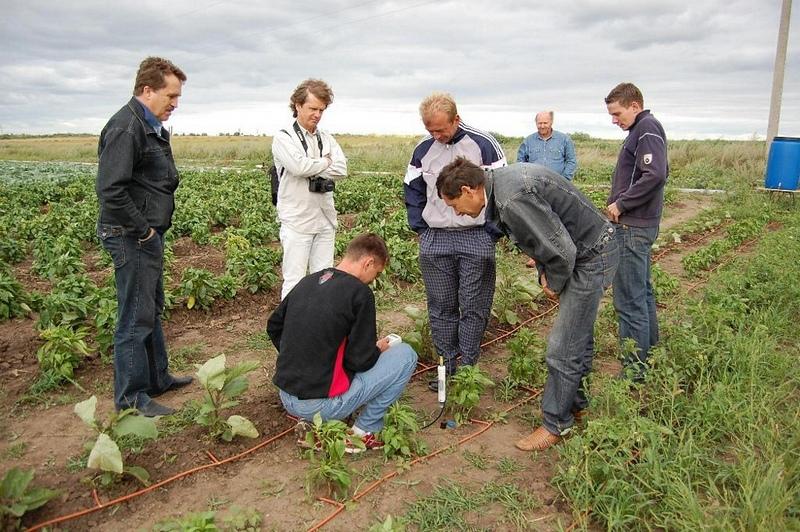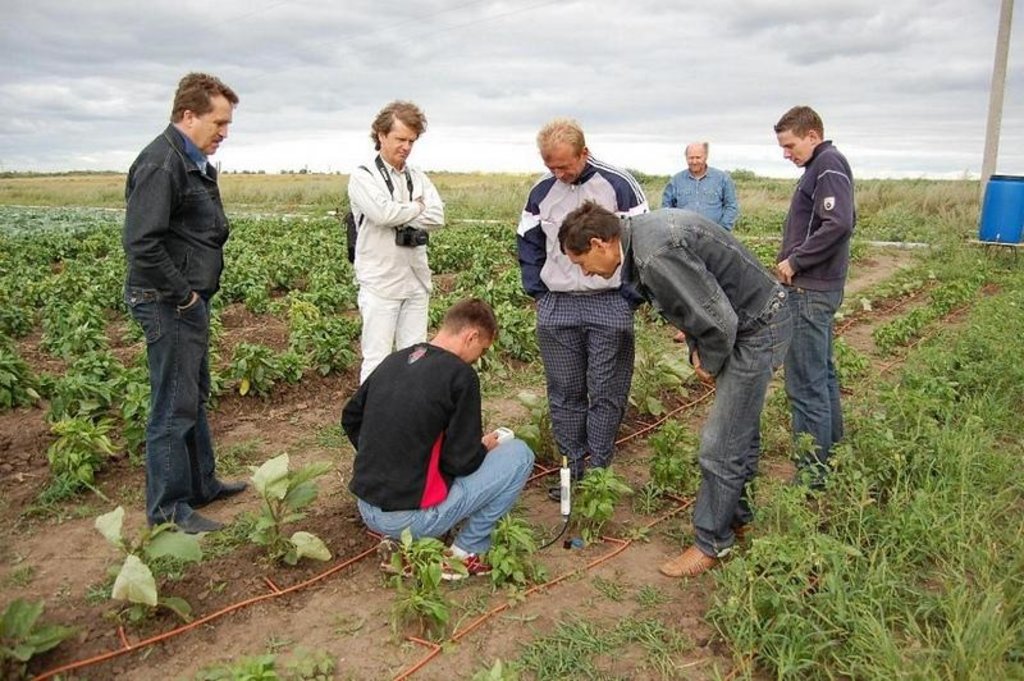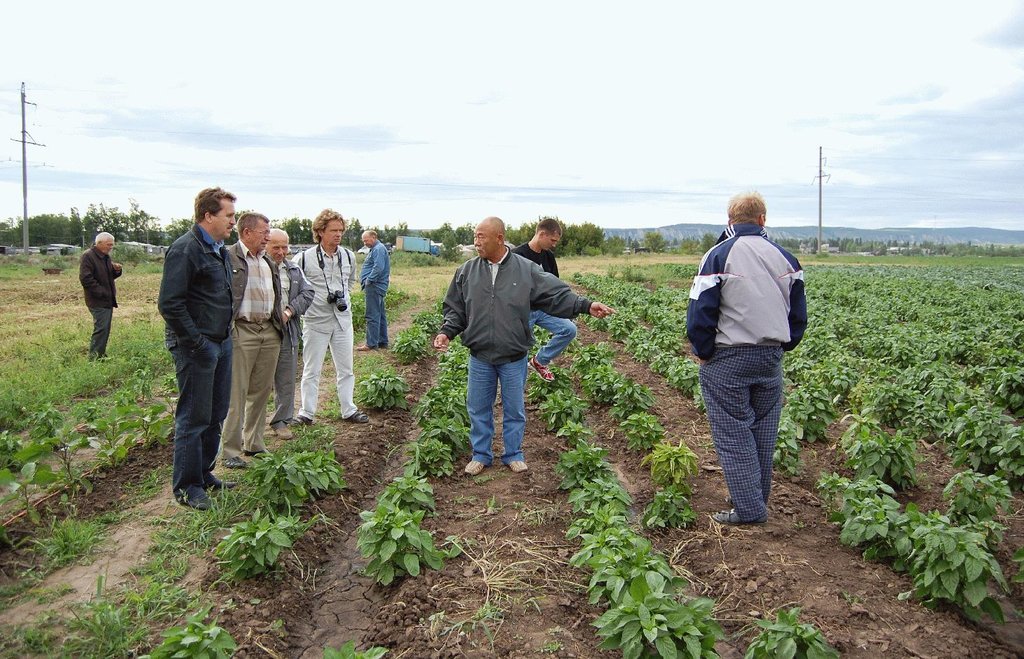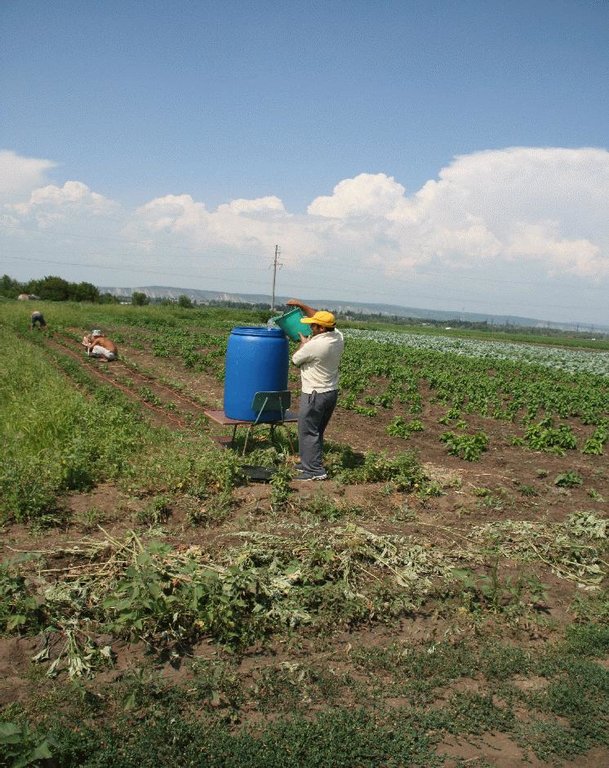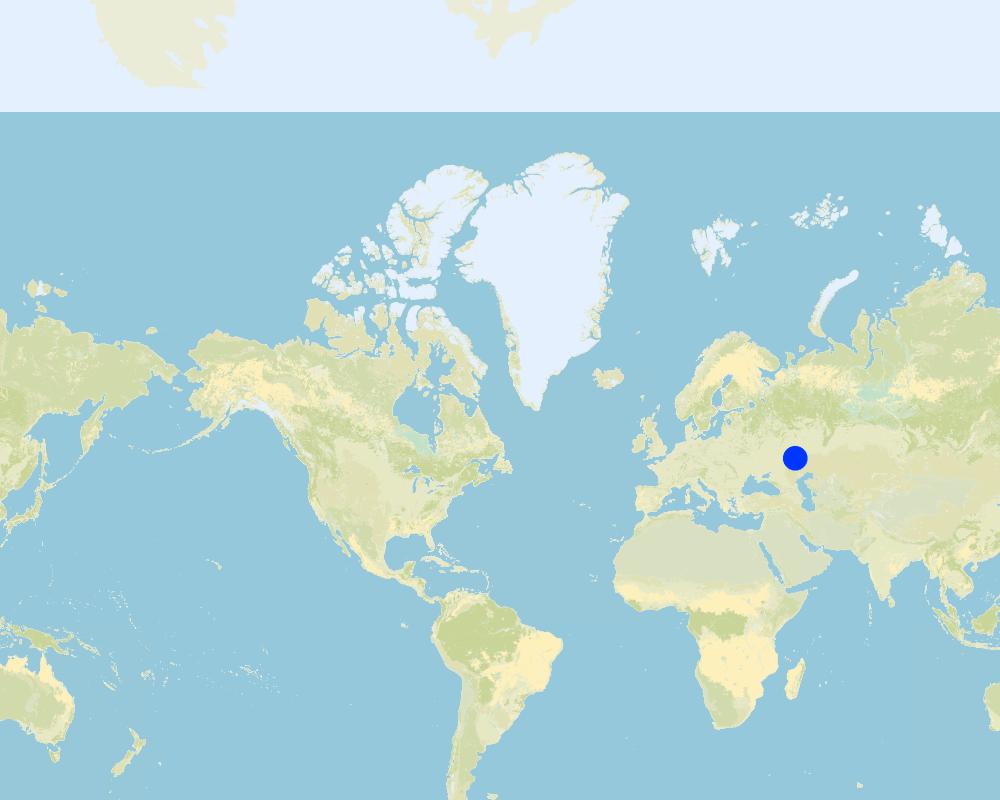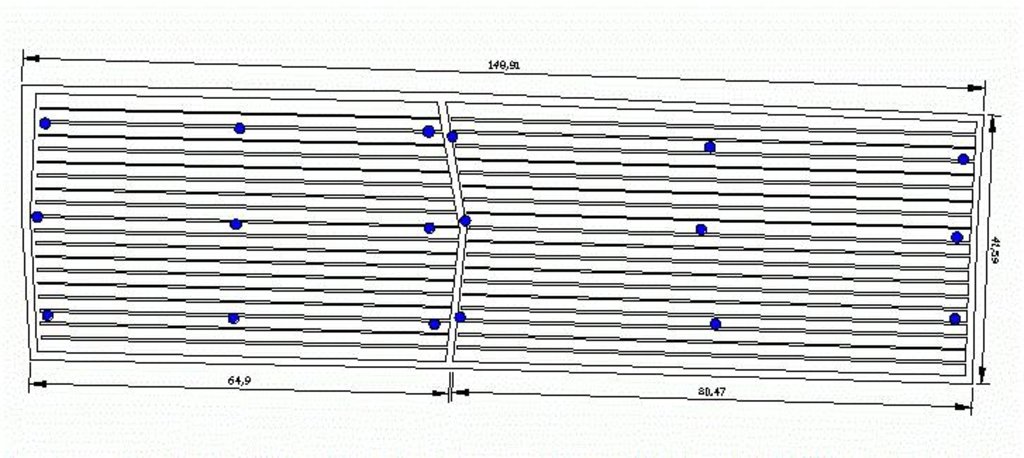Drip irrigation [الاتحاد الروسي]
- تاريخ الإنشاء:
- تحديث:
- جامع المعلومات: Anatoly Zeyliger
- المحرر: –
- المراجعون: Deborah Niggli, Alexandra Gavilano
Капельное орошение (in Russian)
technologies_1371 - الاتحاد الروسي
عرض الأقسام
توسيع الكل طي الكل1. معلومات عامة
1.2 تفاصيل الاتصال بالأشخاص الرئيسيين لمصدر المعلومات والمؤسسات المشاركة في تقييم وتوثيق التقنية
اسم المشروع الذي سهّل توثيق/تقييم التقنية (إذا كان ذلك على صلة)
DESIRE (EU-DES!RE)1.3 الشروط المتعلقة باستخدام البيانات الموثقة من خلال WOCAT
يوافق جامع المعلومات والشخص (لاشخاص) الرئيسي لمصدر المعلومات على الشروط المتعلقة باستخدام البيانات الموثقة من خلال WOCAT:
نعم
1.4 إعلان بشأن استدامة التقنية الموصوفة
هل التقنية الموصوفة هنا تمثل مشكلة فيما يتعلق بتدهور الأراضي، بحيث لا يمكن إعلانها تقنية مستدامة لإدارة الأراضي؟:
كلا
1.5 الإشارة إلى الاستبيان (الاستبيانات) حول مناهج الإدارة المستدامة للأراضي (موثقة باستخدام WOCAT)
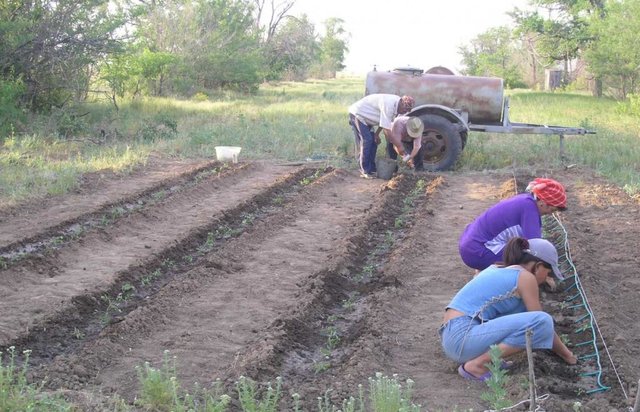
Concerted thinking on common problems of water scarcity [الاتحاد الروسي]
Testing and disseminating of a water-saving technology like drip irrigation
- جامع المعلومات: Anatoly Zeyliger
2. وصف تقنيةالإدارة المستدامي للأراضي
2.1 وصف مختصر للتقنية
تعريف التقنية:
Drip irrigation systems gradually apply water into the zone around the stem of the irrigated plant.
2.2 وصف تفصيلي للتقنية
الوصف:
Drip irrigation experiments have been carried out on the left bank of the Volga River. Economic problems, regional reforms and shortage of investments in municipal water supply infrastructure led to problems of water quality and quantity of available water for industrial, agricultural and domestic uses. The situation is getting worse with the effects of regional climate change. Especially during summer, the study region has problems with shortage of water not just for irrigation of agricultural fields, or gardens, but also for domestic use. In such situations, more efficient water use is required through introducing water-saving technologies. One of these well-known irrigation technologies is drip irrigation. Small quantities of water are directly delivered to the plants by a pipe system. This technology is the most effective from the point of view of green water use efficiency. Correct application of drip irrigation technology drastically decreases water losses by runoff and evaporation as well as deep percolation to soil depths inaccessible to root uptake. Water can be provided to plants from surface water reservoirs, water tanks or groundwater wells through a network of plastic pipes (under low water pressure) and delivered through a water drip system. The flow rate can be adjusted to the needs of the particular stage of plant growth, to soil hydraulic properties and to the prevailing weather conditions. The low-pressure supply system can be operated using a header tank or directly by using a water pump to raise water from nearby surface water storage or a groundwater well.
The aim of this technology is to show the effectiveness of freshwater usage in irrigating vegetables (tomatoes, peppers) at the scale of subsidiary plots or small irrigation systems (several ha in size) in a region with scarce water resources both as a water-saving measure and an eco-friendly alternative to furrow irrigation. Owing to the relative narrowness of the drip feeders, they are prone to blockages from organic matter, mineral particles or dissolved compounds. To prolong the lifetime of the drip irrigation equipment, it needs to be maintained using preventive and remedial measures such as visual inspection of pipes and water supply sources, filter installations as well as flushing the tubes and drip emitters to remove deposits.
In general, a number of medium-scale farmers are using furrow irrigation of vegetables as their main agricultural activity. Drip-irrigation technology was tested with four families and compared to furrow irrigation in order to compare water consumption (water use efficiency as rate of yield and volume of water used for irrigation) as well as its impact on soil degradation and ground-water. The water use efficiency of drip irrigation is 3 - 10 times higher than that of furrow irrigation, depending on local conditions and qualification of furrow irrigators. Furthermore, this technology avoids water loss through soil surface evaporation, percolation to deep soil layers and ground water, and runoff into near water bodies (causing pollution by chemicals used for agricultural activities at irrigated fields like fertilizers and plant protectors). The negative impact of furrow irrigation on soil productivity is usually very high due to soil erosion.
Experimentations and demonstration of drip irrigation were done at two levels. The first level involved large-scale farms with the aim of demonstrating the considerable gains to be made through the efficient use of water, through the development of representative experimental plots on fields used for furrow irrigation by two farmers. The second level was developed for small-scale farmers and householders to demonstrate the efficiency of water saving in gardening.
2.3 صور التقنية
2.5 البلد/المنطقة/المواقع التي تم تنفيذ التقنية فيها والتي يغطيها هذا التقييم
البلد:
الاتحاد الروسي
المنطقة/الولاية/المحافظة:
Saratov Region
مزيد من التفاصيل حول الموقع:
Marksovsky District
حدد انتشار التقنية:
- منتشرة بالتساوي على مساحة
إذا كانت المساحة الدقيقة غير معروفة، فيرجى الإشارة إلى المنطقة التقريبية المغطاة:
- < 0.1 كم2 (10 هكتار)
التعليقات:
Technology now is in testing mode.
Map
×2.6 تاريخ التنفيذ
في حالة عدم معرفة السنة بالتحديد، يرجى الإشارة إلى التاريخ التقريبي:
- منذ أقل من 10 سنوات (مؤخرًا)
2.7 إدخال التقنية
حدد كيف تم إدخال التقنية:
- من خلال المشاريع/ التدخلات الخارجية
3. تصنيف تقنية الإدارة المستدامي للأراضي
3.1 الغرض الرئيسي ( الأغراض الرئيسية) للتقنية
- الحد من تدهور الأراضي ومنعه وعكسه
3.2 نوع (أنواع) استخدام الأراضي الحالية حيث يتم تطبيق التقنية

الأراضي الزراعية
- زراعة سنوية
عدد مواسم الزراعة في السنة:
- 1
حدد:
Longest growing period in days: 120, Longest growing period from month to month: May - Sept
التعليقات:
Major land use problems (compiler’s opinion): Scarcity of fresh water resources, change of local seasonal climate patterns related to change in rainfall, scarcity of freshwater resources, soil salinization, disappearance of some species of flora and fauna
Major land use problems (land users’ perception): Scarcity of fresh water resources, change of local seasonal climate patterns related to change in rainfall, scarcity of freshwater resources, soil salinization, disappearance of some species of flora and fauna
Type of cropping system and major crops comments: Some changes in the cropping system can be seen as there are several years of water shortage can be observed.
Livestock is grazing on crop residues
3.4 إمدادات المياه
إمدادات المياه للأرض التي يتم تنفيذ التقنية عليها:
- بعلية
3.5 مجموعةالإدارة المستدامة للأراضي التي تنتمي إليها هذه التقنية
- إدارة الري (بما في ذلك إمدادات المياه والصرف الصحي)
- تحويل المياه والصرف
3.6 التدابير التقنية في مجال إلادارة المستدامة للأراضي

التدابير البنيوية
- S11: غير ذلك
3.7 الأنواع الرئيسية من تدهور الأراضي التي تناولتها التقنية

تآكل التربة بالمياه
- الوزن(Wt): فقدان التربة السطحية/تآكل السطح

التدهور الكيميائي للتربة
- (Cs): التملح/ القلونة

تدهور المياه
- (Hp): تدهور نوعية المياه السطحية
التعليقات:
Main causes of degradation: disturbance of water cycle (infiltration / runoff) (Disappearing of water sources produced by spring runoff (ponds). However, this disturbance is natural, appear due to changes in nature. Snow melted water (in the absence of frosted topsoil) infiltrate), inputs and infrastructure: (roads, markets, distribution of water points, other, …) (The water distribution system has no possibilities equally distribute water in village. People living at end of village have no water for domestic use, in beginning all water resouces were taken)
Secondary causes of degradation: change of seasonal rainfall (Quantity of rainfalls decreased)
3.8 منع أو حد أو عكس تدهور الأراضي
تحديد هدف التقنية فيما يتعلق بتدهور الأراضي:
- الحد من تدهور الأراضي
4. المواصفات الفنية، وأنشطة التنفيذ، والمدخلات، والتكاليف
4.1 الرسم الفني للتقنية
المواصفات الفنية (المتعلقة بالرسم الفني):
Schematic diagram of an experimental plot with drip irrigation at the large-scale farm level, showing the location of access tubes for soil moisture monitoring
Location: Romashki village. Pallasovsky District
Date: 01/06/2008
Technical knowledge required for field staff / advisors: moderate
Technical knowledge required for land users: moderate
Main technical functions: saving water resources
Secondary technical functions: increase in organic matter, promotion of vegetation species and varieties (quality, eg palatable fodder)
Structural measure: irrigation system
Construction material (other): plastic tubes, water tank
Slope (which determines the spacing indicated above): 1.00%
المؤلف:
Semenov V.
4.2 معلومات عامة بخصوص حساب المدخلات والتكاليف
عملة أخرى/ عملة وطنية (حدد):
ruble
إذا كان ذا صلة، وضح سعر الصرف من الدولار الأمريكي إلى العملة المحلية (على سبيل المثال، 1 دولار أمريكي = 79.9 ريال برازيلي): 1 دولار أمريكي =:
35,0
اذكر متوسط تكلفة أجر العمالة المستأجرة في اليوم الواحد:
15.00
4.3 أنشطة التأسيس
| النشاط | التوقيت (الموسم) | |
|---|---|---|
| 1. | installation of pipe network | |
| 2. | tapping the source of water supply |
4.4 التكاليف والمدخلات اللازمة للتأسيس
| تحديد المدخلات | الوحدة | الكمية | التكاليف لكل وحدة | إجمالي التكاليف لكل مدخل | % من التكاليف التي يتحملها مستخدمو الأراضي | |
|---|---|---|---|---|---|---|
| العمالة | labour | ha | 1,0 | 60,0 | 60,0 | 100,0 |
| معدات | tools | ha | 1,0 | 3000,0 | 3000,0 | |
| إجمالي تكاليف إنشاء التقنية | 3060,0 | |||||
| إجمالي تكاليف إنشاء التقنية بالدولار الأمريكي | 87,43 | |||||
التعليقات:
Duration of establishment phase: 3 month(s)
4.5 الصيانة/الأنشطة المتكررة
| النشاط | التوقيت/الوتيرة | |
|---|---|---|
| 1. | Reinstallation of pipe network every year |
4.6 التكاليف والمدخلات اللازمة للصيانة/للأنشطة المتكررة (سنويًا)
| تحديد المدخلات | الوحدة | الكمية | التكاليف لكل وحدة | إجمالي التكاليف لكل مدخل | % من التكاليف التي يتحملها مستخدمو الأراضي | |
|---|---|---|---|---|---|---|
| العمالة | labour | ha | 1,0 | 60,0 | 60,0 | 100,0 |
| إجمالي تكاليف صيانة التقنية | 60,0 | |||||
| إجمالي تكاليف صيانة التقنية بالدولار الأمريكي | 1,71 | |||||
التعليقات:
Costs are given for 1 ha of land.
4.7 أهم العوامل المؤثرة على التكاليف
قدم وصفا لأهم العوامل التي تؤثر على التكاليف:
The pipe system is the most determining factor affecting the costs.
5. البيئة الطبيعية والبشرية
5.1 المناخ
هطول الأمطار السنوي
- < 250 مم
- 251- 500 ملم
- 501 - 750ملم
- 1,000-751 ملم
- 1,500-1,100 ملم
- 2,000-1,500 ملم
- 3,000-2,001 ملم
- 4,000-3,100 ملم
- > 4000 ملم
المواصفات/التعليقات على هطول الأمطار:
summer time 150-200, annual 300-350
المنطقة المناخية الزراعية
- شبه قاحلة
Thermal climate class: temperate
5.2 طوبوغرافيا
متوسط الانحدارات:
- مسطح (0-2%)
- بسيط (3-5%)
- معتدل (6-10%)
- متدحرج (11-15%)
- تلال (16-30%)
- شديدة الانحدار(31-60%)
- فائقة الانحدار (>60%)
التضاريس:
- هضاب/سهول
- أثلام مرتفعة
- المنحدرات الجبلية
- منحدرات التلال
- منحدرات في السفوح
- قاع الوادي
المنطقة الارتفاعية:
- 100-0 متر فوق سطح البحر
- 500-101 متر فوق سطح البحر
- 1,000-501 متر فوق سطح البحر
- 1,500-1,001 متر فوق سطح البحر
- 2,000-1,501 متر فوق سطح البحر
- 2,500-2,100 متر فوق سطح البحر
- 3,000-2,501 متر فوق سطح البحر
- 4,000-3,001 متر فوق سطح البحر
- > 4000 متر فوق سطح البحر
5.3 التربة
متوسط عمق التربة:
- ضحل جدًا (0-20 سم)
- ضحلة (21-50 سم)
- متوسطة العمق (51-80 سم)
- عميقة (81-120 سم)
- عميقة جدًا (> 120 سم)
قوام التربة (التربة السطحية):
- متوسط ( طميي، سلتي)
المواد العضوية في التربة السطحية:
- منخفضة (<1%)
5.4 توافر المياه ونوعيتها
منسوب المياه الجوفية:
50-5 م
توافر المياه السطحية:
ضعيف/ غير متوافر
نوعية المياه (غير المعالجة):
للاستخدام الزراعي فقط (الري)
5.5 التنوع البيولوجي
تنوع الأنواع:
- منخفض
5.6 خصائص مستخدمي الأراضي الذين يطبقون التقنية
التوجه السوقي لنظام الإنتاج:
- الكفاف (الإمداد الذاتي)
- مختلط (كفاف/ تجاري)
الدخل من خارج المزرعة:
- أقل من % 10من كامل الدخل
المستوى النسبي للثروة:
- ضعيف جدا
- ضعيف
أفراداً أو مجموعات:
- فرد/أسرة معيشية
مستوى المكننة:
- عمل يدوي
- ميكانيكية/ مزودة بمحرك
اذكر الخصائص الأخرى ذات الصلة لمستخدمي الأراضي:
Population density: < 10 persons/km2
Annual population growth: < 0.5%
70% of the land users are poor and own 80% of the land.
30% of the land users are poor and own 20% of the land.
5.7 متوسط مساحة الأرض التي يستخدمها مستخدمو الأراضي الذين يطبقون التقنية
- < 0.5 هكتارا
- 0.5 - 1 هكتار
- 1 -2 هكتار
- 2 - 5 هكتار
- 5 - 15 هكتار
- 15 - 50 هكتار
- 50 - 100هكتار
- 500-100 هكتار
- 1,000-500 هكتار
- 10,000-1,000 هكتار
- > 10,000 هكتار
هل يعتبر هذا نطاقًا صغيرًا أو متوسطًا أو واسعا (في إشارة إلى السياق المحلي)؟:
- على نطاق صغير
5.8 ملكية الأراضي، وحقوق استخدام الأراضي، وحقوق استخدام المياه
ملكية الارض:
- مجتمعي/قروي
حقوق استخدام الأراضي:
- مجتمعي (منظم)
- فردي
حقوق استخدام المياه:
- مجتمعي (منظم)
- فردي
5.9 الوصول إلى الخدمات والبنية التحتية
الصحة:
- ضعيف
- معتدل
- جيد
التعليم:
- ضعيف
- معتدل
- جيد
المساعدة التقنية:
- ضعيف
- معتدل
- جيد
العمل (على سبيل المثال خارج المزرعة):
- ضعيف
- معتدل
- جيد
الأسواق:
- ضعيف
- معتدل
- جيد
الطاقة:
- ضعيف
- معتدل
- جيد
الطرق والنقل:
- ضعيف
- معتدل
- جيد
مياه الشرب وخدمات الصرف الصحي:
- ضعيف
- معتدل
- جيد
الخدمات المالية:
- ضعيف
- معتدل
- جيد
6. الآثار والتصريحات الختامية
6.1 الآثار التي أظهرتها التقنية في الموقع
الآثار الاجتماعية والاقتصادية
الإنتاج
إنتاج المحاصيل
تنوع المنتج
توافر المياه ونوعيتها
الطلب على مياه الري
آثار اجتماعية واقتصادية أخرى
relatively high costs for purchasing, installation and maintenance
الآثار الاجتماعية والثقافية
الأمن الغذائي / الاكتفاء الذاتي
contribution to human well-being
التعليقات/ حدد:
This technology will help people to receive more diverse table.
الآثار الايكولوجية
دورة المياه / الجريان السطحي
التبخر
التربة
رطوبة التربة
6.2 الآثار التي أظهرتها التقنية خارج الموقع
no runoff, no water erosion, no ground water rising
6.3 تعرض التقنية وحساسيتها لتغير المناخ التدريجي والظواهر المتطرفة/الكوارث المرتبطة بالمناخ (كما يراها مستخدمو الأراضي)
الظواهر المتطرفة / الكوارث المرتبطة بالمناخ
الكوارث المناخية
| كيف تتعامل التقنية مع ذلك؟ | |
|---|---|
| جفاف | ليس جيدا |
6.4 تحليل التكلفة والعائد
كيف يمكن مقارنة العوائد نسبة لتكاليف الإنشاء (من وجهة نظر مستخدمي الأراضي)؟
عوائد قصيرة الأجل:
محايد/متوازن
عوائد طويلة الأجل:
إيجابي
كيف تتم مقارنة العوائدمع كلفة الصيانة/التكاليف المتكررة (من وجهة نظر مستخدمي الأراضي)؟
عوائد قصيرة الأجل:
إيجابي
عوائد طويلة الأجل:
إيجابي
التعليقات:
Even in first year the labour time is much less compare to the labour needed for irrigation by furrows.
6.5 اعتماد التقنية
- > 50%
التعليقات:
100% of land user families have adopted the Technology with external material support
4 land user families have adopted the Technology with external material support
The system is at an experimental phase.
There is a moderate trend towards spontaneous adoption of the Technology
People are interested in the technology and are watching their benefits on the experimental plots
6.7 نقاط القوة / المزايا / الفرص التي توفرها التقنية
| نقاط القوة/ المزايا/ الفرص من وجهة نظر مستخدمي الأراضي |
|---|
| Saving of the water |
| Diversification of crop production |
| نقاط القوة/ المزايا/ الفرص من وجهة نظر جامع المعلومات أو غيره من الاشخاص الرئيسيين لمصدر المعلومات |
|---|
| Saving of the water |
| Diversification of crop production |
| Savings of soil fertility |
6.8 نقاط ضعف / مساوىء / مخاطر التقنية وسبل التغلب عليها
| نقاط الضعف/ المساوىء/ المخاطر من وجهة نظر جامع المعلومات أو غيره من الاشخاص الرئيسيين لمصدر المعلومات | كيف يمكن التغلب عليها؟ |
|---|---|
| Requires preventive and regular maintenance | monitoring and independent control of water use efficiency as well as through financial instruments (pressure on inefficient users) |
| High investment costs due to expensive pipe system | provide subsidies for drip irrigation user. |
7. المراجع والروابط
7.1 طرق جمع/مصادر المعلومات
- زيارات ميدانية، مسوحات ميدانية
- مقابلات مع مستخدمي الأراضي
متى تم تجميع البيانات (ميدانيا)؟:
20/10/2011
7.2 المراجع للمنشورات المتاحة
العنوان، المؤلف، السنة، النظام القياسي الدولي لترقيم الكتب ISBN:
Zeiliguer, A., G. Sokolova, V. Semeonv, O. Ermolaeva. Results of field experimentations at 2008 to grow tomatoes under drip irrigation at Pallasovsky District of Volgograd Region.
متاح من أين؟كم التكلفة؟:
Proceeding of conference at MSUEE. 2008, p. 45-56.
الروابط والوحدات المواضيعية
توسيع الكل طي الكلالروابط

Concerted thinking on common problems of water scarcity [الاتحاد الروسي]
Testing and disseminating of a water-saving technology like drip irrigation
- جامع المعلومات: Anatoly Zeyliger
الوحدات المواضيعية
لا يوجد وحدات مواضيعية


